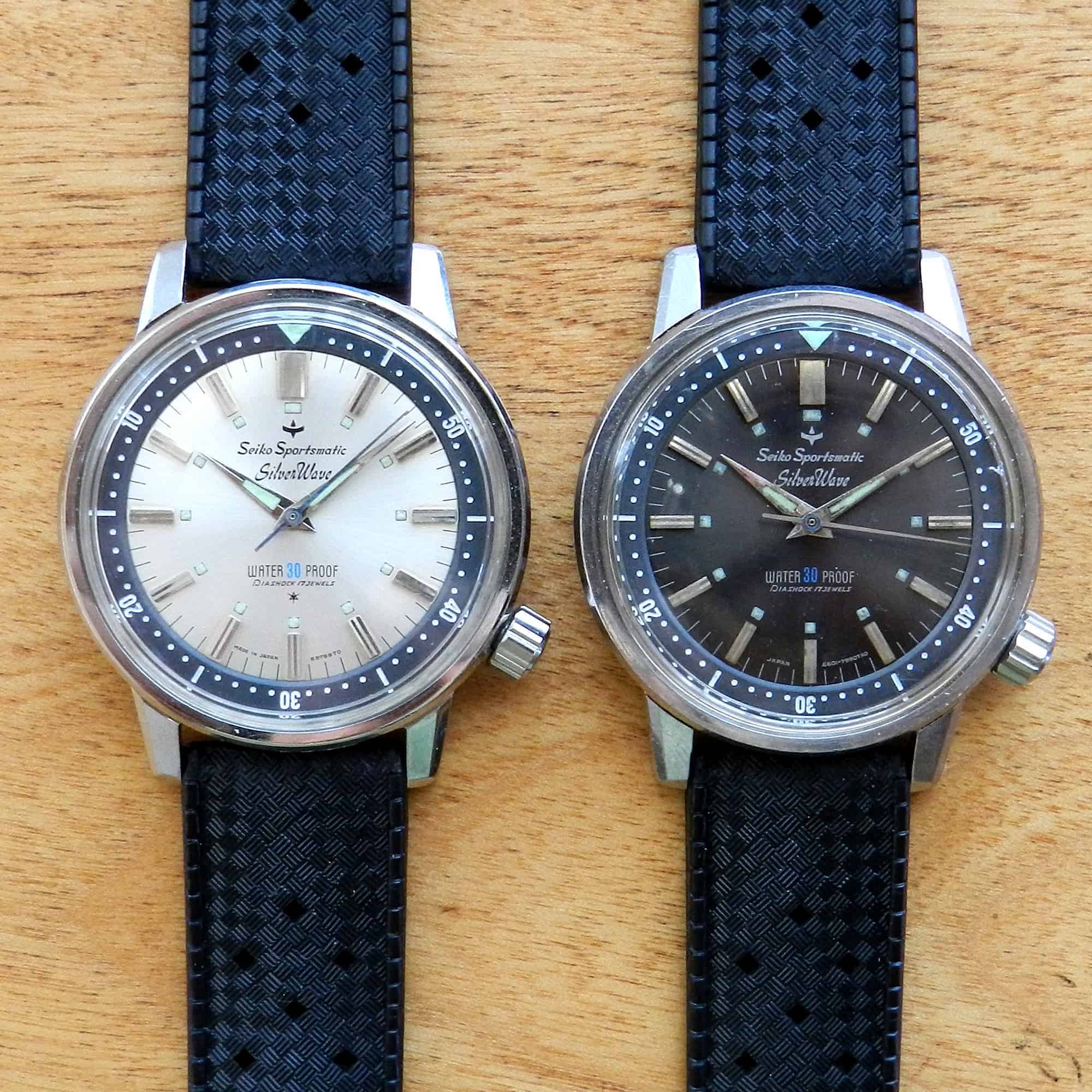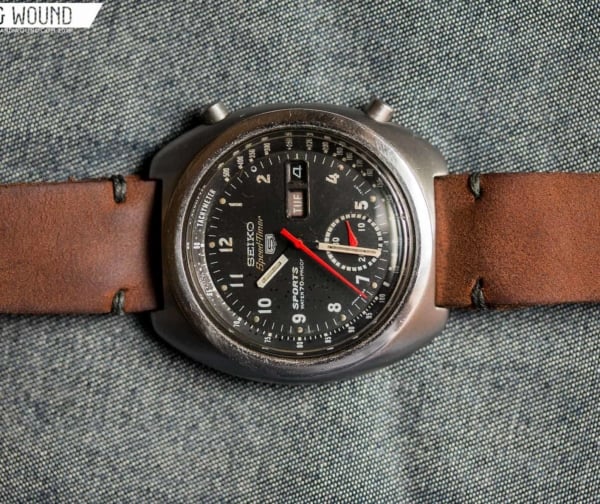Before Seiko released their iconic 6217, 6159, 62MAS and 6105 divers, there was the SilverWave, their first attempt at a ‘real’ diving watch. While only rated to 50m initially, the SilverWave wasn’t truly a professional tool dive watch, but it was the humble beginning to a venerable line of true divers that continues to today.
The SilverWave was introduced in 1961 with a water resistance rating of 50 meters. It featured a two-piece screw in back, an internal rotating diver’s bezel and an oversized crown at 4 o’clock. In 1964 Seiko switched the caseback to a snap-on back and the rating was lowered to 30 meters. The subject of this article is the later 30m SilverWave, model 6601-7990.
The SilverWave is one of the absolute coolest divers Seiko ever made, and has become somewhat of a cult classic amongst Seikoholics. While not really rare, they are somewhat scarce, particularly in good condition. It would seem that folks actually used these divers for their intended purpose (imagine that!), and their water resistance didn’t really hold up over time. Most examples found today exhibit varying degrees of signs of moisture intrusion, resulting in heavy patina on the dial, especially to the lume on the dial and hands. That said, nice examples are out there, and they really are a good looking watch.
The SilverWave 30m came in two versions, a silver dial and a black dial, both with a black inner rotating diver’s bezel. The symmetrical no-date dials have a radial brushed finish and applied steel baton markers with lume dots at the inner edge of the markers. The steel dauphine hands have large lume filled centers. The lume Seiko used on these was a kind of light mint green, which when in good shape looks really nice. Sadly, the lume often succumbs to the common ‘black funk’ found on vintage Seiko divers.
Both dial versions came with a black plastic internal countdown bezel, with a lumed triangle at zero. This internal bezel is a similar set up to several other Seiko models that came later, with the bezel sitting atop a spring washer, and the crystal resting on top of the bezel, keeping the whole mechanism in place. Due to the type of plastic used, these black bezels tend to fade easily in the sun. Most examples found today have faded to varying shades of grey.
When the crown is in the ‘in’ position, turning it will rotate the bezel in either direction. The crown is large when compared to other Seiko models out at the time, and featured a sort of fancy knurling that makes it easier to grip. Like most of the later Seiko divers, the crown/stem gasket is located inside the crown, rather than on the stem. This makes it (nearly) impossible to replace the gasket, so the whole crown needs to be replaced when the gasket goes bad. Fortunately for collectors, there are NOS crowns out there to be had.
The case measures a healthy 37.5mm wide by 44mm long, with a lug width of 18mm. The watch wears even larger than it measures due to the big, flat topped crystal and narrow external bezel, giving it a generous wrist presence. Like mentioned above, the caseback is a snap-on type with an o-ring gasket. The back has the classic Seiko ‘wave’ logo on it, but it is fairly lightly engraved. Sadly, even a modest polishing can make the back nearly unreadable on these early Seiko divers. Just one of the many reasons why I find case polishing to be abominable.
The overall look with the internal bezel, large crystal and oversized fancy crown at 4 o’clock gives this model an easily recognizable style that is unique and coveted by Seiko fans and is fast becoming more popular with the general WIS crowd. The movement in this model is a caliber 6601, a 17 jewel automatic without date function. While unspectacular, it is an efficient and robust movement that gets the job done (like most Seikos…). The earlier 50m models used a 20 jewel automatic caliber 603, which is nearly identical.
I believe these came on a strap originally, as I have yet to see definitive proof that bracelets were an option. Of course, there could have been an OEM bracelet, I just haven’t found one yet. That said, there are several vintage Seiko bracelets that will fit this case, and I’ve had a Seiko beads of rice bracelet fitted to one of my SilverWaves before that looked super sharp. Currently the two that I have are fitted with vintage Tropic straps, probably very similar to what they would have originally had.
Seiko used the SilverWave moniker from 1961 until sometime in the early 1980’s I believe. The first 50m internal bezel version came in silver and black like the later 30m versions. However, the 50m also came in a silver dial version with an insanely cool ‘sunburst’ radial pattern that cut across the dial at each of the hour markers. These are very difficult to find these days and command a substantial premium over the more common variants. In the mid-late 1960’s, Seiko discontinued the cool internal bezel version, and made many different standard analogue variants, both automatic and quartz. Later they transitioned the SilverWave name to some of their LCD watches, one of which was featured in the James Bond movie “Octopussy”.
The classic SilverWave with internal bezel is one that has gotten really hot lately, and when they show up on eBay there are usually lots of bidders. The 30m versions can be had for anywhere between $200 and $500 depending on condition and seller. The 50m versions tend to be considerably harder to find, and fetch a bit more, especially the ‘sunburst’ variant. Fortunately, parts for these watches aren’t impossible to find. Crystals and crowns are relatively easy to source, but the internal bezel and spring washer are another matter entirely. The hardest part is finding one with a nice dial and hands, but if you’re patient, they can be found.









 Featured Videos
Featured Videos












